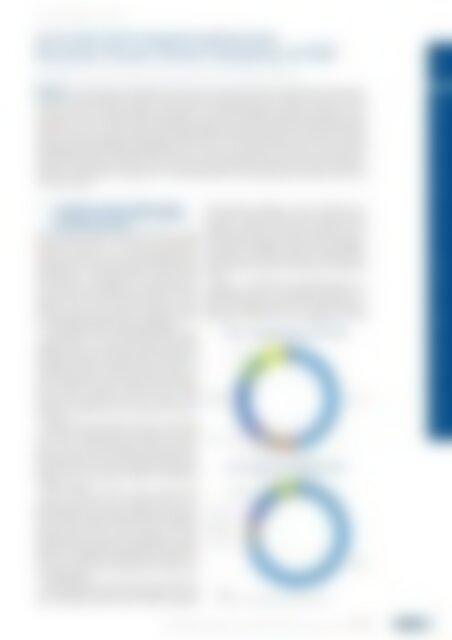You also want an ePaper? Increase the reach of your titles
YUMPU automatically turns print PDFs into web optimized ePapers that Google loves.
<strong>atw</strong> Vol. 64 (<strong>2019</strong>) | Issue 3 ı March<br />
Feature | Major Trends in Energy Policy and Nuclear Power<br />
Nuclear Power Plant Flexibility at EDF<br />
Patrick Morilhat, Stéphane Feutry, Christelle Lemaitre and Jean Melaine Favennec<br />
Based upon existing experience feedback of French nuclear power plants operated by EDF (Electricité de France),<br />
this paper shows that flexible operation of nuclear reactors is possible and has been applied in France by EDF’s 58<br />
reactors for more than 30 years without any noticeable or unmanageable impacts: no effects on safety or on the<br />
environment, and no noticeable additional maintenance costs, with an additional unplanned capability load factor<br />
estimated at only 0.5 %. EDF’s nuclear reactors have the capability to vary their output between 20 % and 100 % within<br />
30 minutes, twice a day, when operating in load-following mode. Flexible operation requires sound plant design (safety<br />
margins, auxiliary equipment) and appropriate operator skills, and early modifications were made to the initial<br />
Westinghouse design to enable flexible operation (e.g., use of “grey” control rods to vary reactor core thermal power<br />
more rapidly than with conventional “black” control rods). The nominal capacities of the present power stations are<br />
sufficient, safe and adequate to balance generation against demand and allow renewables to be inserted intermittently,<br />
without any additional CO 2 emissions. It is a clear demonstration of full complementarity between nuclear and<br />
renewable energies.<br />
1 Introduction: Nuclear and Renewable<br />
energies are the two pillars of France’s<br />
low carbon electricity<br />
The fight against climate change has entered a crucial<br />
phase with the objective set by COP 21 to keep global<br />
warming “well below” +2 °C at the horizon 2100. Today,<br />
energy accounts for most CO 2 emissions worldwide and the<br />
electricity sector in particular is a prime candidate for deep<br />
decarbonization. A recent MIT study [1] says that unless<br />
nuclear energy is incorporated into the global mix of<br />
low-carbon energy technologies, the challenge of climate<br />
change will be much more difficult and costly to meet.<br />
Although nuclear energy raises the problem of nuclear<br />
waste management, solutions have been identified, and it is<br />
the climate change challenge that is overwhelming.<br />
In this respect, France – which already has low carbon<br />
intensity facilities – is a step ahead of its major European<br />
neighbours. This low carbon and competitive mix must be<br />
preserved in the long term, drawing on the complementary<br />
relationship between renewable energy sources and<br />
nuclear energy. France’s electricity generation is built on a<br />
mix of varied generation units, based upon nuclear power<br />
plants (NPPs), renewable energies sources (RES)<br />
consisting of hydropower plants, wind turbines, solar<br />
farms or biomass plants and a few remaining set of conventional<br />
units.<br />
With an overall net generation capacity of 129.3 GWe<br />
(92.3 GWe in mainland France), generating 580.8 TWh<br />
(424.7 TWh in mainland France) in 2017 [2], the EDF<br />
group is one of the world’s leading electricity producers.<br />
EDF’s fleet generates 87 % carbon-free electricity, due to<br />
the predominance of nuclear and hydropower generation<br />
facilities, in an increasingly restrictive environmental<br />
regulatory context.<br />
EDF is among the world’s 10 largest global power<br />
suppliers, and produces the smallest amount of CO 2<br />
per kilowatt-hour, with direct emissions currently at<br />
82 gCO 2 /kWh 2 (25gCO 2 /kWh for EDF France Mainland),<br />
which is far less than the world average for the sector<br />
(506gCO2/kWh in 2015) and the average for the main<br />
European electricity providers (275gCO 2 /kWh in 2016).<br />
EDF group’s decarbonization strategy is first and foremost<br />
based on an ambitious industrial policy focused on a<br />
low-carbon generation with a balanced mix of nuclear and<br />
renewable energy.<br />
More specifically concerning nuclear power, EDF is the<br />
world’s biggest NPP operator. EDF operates 58 nuclear<br />
units in mainland France, based on PWR (Pressurized<br />
Water Reactor) technology; A “unit” is defined here as<br />
a generation facility including a reactor, steam generators,<br />
a turbine, a generator, the related equipment and the<br />
buildings that house them. These units are spread over 19<br />
sites, with an average age of 32 years. They are divided into<br />
three series according to the electrical power available:<br />
a 900 MW series consisting of 34 units, a 1,300 MW series<br />
consisting of 20 units, and a 1,500 MW series consisting of<br />
4 units.<br />
Built in the 1980-90s and originally based on a<br />
Westinghouse design, with upgrades implemented by<br />
EDF and Framatome, the French nuclear fleet grew at a<br />
quick pace, reaching about 72 % of the total electricity<br />
generated in France [3] in 2017 (see Figure 1), 89 % of<br />
France's Installed capacity (130.7 GW)<br />
France's Electricity output (530 TWh)<br />
| | Fig. 1.<br />
France's 2017 installed capacity and electricity output [3].<br />
FEATURE | MAJOR TRENDS IN ENERGY POLICY AND NUCLEAR POWER 131<br />
Feature<br />
Nuclear Power Plant Flexibility at EDF ı Patrick Morilhat, Stéphane Feutry, Christelle Lemaitre and Jean Melaine Favennec

















